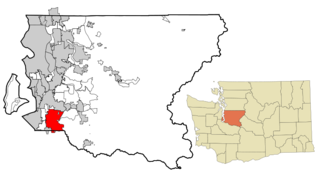
Hilo is the largest settlement in Hawaii County, Hawaii, United States, which encompasses the Island of Hawaii, and is a census-designated place (CDP). The population was 44,186 according to the 2020 census. It is the fourth-largest settlement in the state of Hawaii and largest settlement in the state outside of Oahu.

Route 200, known locally as Saddle Road, traverses the width of the Island of Hawaiʻi, from downtown Hilo to its junction with Hawaii Route 190 near Waimea. The road was once considered one of the most dangerous paved roads in the state, with many one-lane bridges and areas of marginally maintained pavement. Most of the road has now been repaved, and major parts have new re-alignments to modern standards. The highway is mostly one-lane in each direction, but there are two lanes on the uphill portions. The highway reaches a maximum elevation of 6,632 feet (2,021 m) and is subject to fog and low visibility. Many rental car companies used to prohibit use of their cars on Saddle Road, but now allow use of the road. The highway experiences heavy use as it provides the shortest driving route from Hilo to Kailua-Kona and access to the slopes of Mauna Loa and the Mauna Kea Observatories.

Hornstine v. Moorestown, 263 F. Supp. 2d 887, was a 2003 case in the United States District Court for the District of New Jersey that considered whether grades received by a student with a disability for classes where accommodations had been made under an Individualized Education Program could be discounted in awarding valedictorian honors. Blair Hornstine, then in her final year at Moorestown High School, sued the Moorestown Township Public Schools Board of Education to stop them "from retroactively applying to her a proposed policy amendment that would allow the designation of multiple valedictorians". Under the then existing school policy, Hornstine would have been the sole recipient of the honor.

Auburn School District No. 408 is a public school district in King County, Washington, seated in Auburn. The district encompasses a 62 square-mile area bridging King County, Washington and Pierce County, Washington, and serves approximately 75,000 residents in Auburn, Algona, Pacific, and a small portion of Kent, as well as unincorporated census-designated places such as Lake Morton-Berrydale and Lake Holm.

The Oregon School Activities Association (OSAA) is a non-profit, board-governed organization that regulates high school athletics and competitive activities via athletic conferences in the U.S. state of Oregon, providing equitable competition among its members, both public and private. The OSAA is based in Wilsonville.

Hurricane High School is the only high school in Hurricane, Utah, United States. It enrolls students in grades 10–12 from Hurricane and surrounding communities, including La Verkin, Toquerville, Hildale, Virgin, Rockville, and Springdale. As of the 2022 school year, there are 1,141 students enrolled. The student population has grown by 9% over the last five school years. In 2017, a total of 296 students graduated with an 89% graduation rate. USBE Data and Research 2017
The Hawaiʻi Belt Road is a modern name for the Māmalahoa Highway and consists of Hawaiʻi state Routes 11, 19, and 190 that encircle the Island of Hawaiʻi. The southern section, between Hilo and Kailua-Kona is numbered as Route 11. The section between Hilo and Waimea is Route 19. Between Waimea and Kailua-Kona, the road is split in two: the original "mauka" route and a "makai" Route 19, completed in 1975, which serves as access to the Kona and Kohala Coast resorts. In the Hawaiian language, mauka means "towards the mountain" and makai means "towards the sea". These terms are commonly used in travel directions.
William Nottingham High School is a public high school located at 3100 East Genesee Street in Syracuse, New York. Part of the Syracuse City School District, the high school has an enrollment of about 1350 students in grades 9–12.

Nacogdoches High School is located in north east Nacogdoches, Texas.
Campbell High School is a public high school and International Baccalaureate magnet school located in Smyrna, Georgia (U.S.), northwest of Atlanta. It is part of the Cobb County School District. The school implemented the International Baccalaureate diploma program in 1997, serving as a magnet school for the Cobb County School District.
Mountain Ridge High School is a high school in Frostburg, Maryland, United States, that houses over 1000 students from the Georges Creek Valley, the Greater Frostburg vicinity, and the Westernport region. Mountain Ridge is part of Allegany County Public Schools. The school mascot is a miner and the school colors are red, black, white and gold.
Kapaʻa High School is a public high school in Kapaʻa, Hawaii on the island of Kauaʻi.
Garden City High School is a public high school located in Garden City, Michigan, United States.

Charlotte County Public Schools (CCPS) operates all public K-12 schools in Charlotte County, Florida. It covers Port Charlotte, Punta Gorda, Englewood, Rotonda West, Babcock Ranch, and surrounding areas. It operates ten elementary schools, four middle schools, three high schools, and six specialty education centers.

Warrensburg High School (WHS) is a public high school in Warrensburg, Missouri, United States. The school was established in 1896 and the current facility opened in 1987 as a successor to the building that now houses Sterling Elementary School. It is part of the Warrensburg R-VI School District. As of the 2022–23 school year, the enrollment was 992 students.
Redford Union High School (RUHS) is a secondary school in Redford, Michigan, a suburb of Detroit. The school is affiliated with the Redford Union School District and serves grades 9-12.

St. Joseph School is a private school run by the Roman Catholic Church in Hilo, the second largest city in Hawaii. It serves about 300 students in preschool through 12th grade.

Kalākaua Park is the central "town square" of the city of Hilo, Hawaii. It is surrounded by historic buildings and includes a war memorial.

Jennifer Anne Doudna is an American biochemist who has done pioneering work in CRISPR gene editing, and made other fundamental contributions in biochemistry and genetics. Doudna was one of the first women to share a Nobel in the sciences. She received the 2020 Nobel Prize in Chemistry, with Emmanuelle Charpentier, "for the development of a method for genome editing." She is the Li Ka Shing Chancellor's Chair Professor in the department of chemistry and the department of molecular and cell biology at the University of California, Berkeley. She has been an investigator with the Howard Hughes Medical Institute since 1997.















